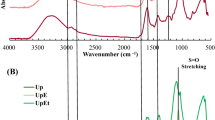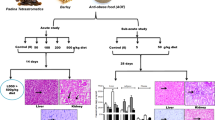Abstract
Sargassum has been used as a supplement diet in domestic animals with a hypolipidemic effect. However, Sargassum is a marine alga that bioaccumulates heavy metals. Marine forests of Sargassum liebmannii develop on the Mexican coasts (North Pacific), and it could be employed as a functional food. Nevertheless, it is necessary to prove its safety regarding intake. This study aimed to examine S. liebmannii for chemical composition, heavy-metal quantification, acute and subchronic toxicities, and its antiobesogenic effect. Sargassum liebmannii provides 790.24 kJ (100 g)−1 and it bioaccumulates higher levels of arsenic (11.2165 ± 0.2793 ppm) compared to zinc, nickel, chromium, copper, lead, cadmium, and mercury (0.0059–0.0437 ppm). The acute toxicity was evaluated in C57BL/6J male mice, obtaining LD50 > 10 g kg−1, and it did not produce any sign of toxicity within 7 days of feeding without histological damage in the stomach, intestine, liver, and kidneys. For the subchronic toxicity and antiobesogenic effect, a diet with 20% S. liebmannii was used in Sprague Dawley male rats for 11 weeks. During the study, the animals fed the Sargassum diet did not show toxicity signs, but body weight gain and energy intake were reduced and insulin sensitivity increased. During the end treatment, the adipose tissue decreased 31.5% from the control. The hematology, clinical biochemistry, and the oxidative stress and cellular damage in the stomach, intestine, liver, and kidneys did not show alterations. These results suggest that a S. liebmannii–supplemented diet (Sls-d) is safe and that it has an antiobesogenic effect in rodents.
Access this article
We’re sorry, something doesn't seem to be working properly.
Please try refreshing the page. If that doesn't work, please contact support so we can address the problem.



Similar content being viewed by others
References
Aeda HAM, Osokawa MAH, Ashima TOS, Iyashita KAM (2007) Dietary combination of fucoxanthin and fish oil attenuates the weight gain of white adipose tissue and decreases blood glucose in obese / diabetic KK-A mice dietary combination of fucoxanthin and fish oil attenuates the weight gain of white adipose tissue. J Agric Food Chem 1:7701–7706
Albert C, Ashauer R, Künsch HR, Reichert P (2012) Bayesian experimental design for a toxicokinetic-toxicodynamic model. J Stat Plan Inference 142:263–275
Alexander PW, Hartati RD, Curtin J (1989) Automated potentiometric end point determination in the Lane-Eynon titration of reducing sugars. Electroanalysis 1:263–269
Asakai T, Murayama M, Tanaka T (2007) Precise coulometric titration of sodium thiosulfate and development of potassium iodate as a redox standard. Talanta 73:346–351
Bilal M, Rasheed JE, Sosa-Hernández A, Raza F, Nabeel HMN (2018) Biosorption: an interplay between marine algae and potentially toxic elements-a review. Mar Drugs 16:65
Bradford MM (1976) A rapid and sensitive method for the quantitation of microgram quantities of protein utilizing the principle of protein-dye binding. Anal Biochem 72:248–254
Bradstreet RB (1954) Kjeldahl method for organic nitrogen. Anal Chem 26:185–187
Bryan GW, Langston WJ (1992) Bioavailability, accumulation and effects of heavy metals in sediments with special reference to United Kingdom estuaries: a review. Environ Pollut 76:89–131
Cardoso SM, Pereira OR, Seca AML, Pinto DCGA, Silva AMS (2015) Seaweeds as preventive agents for cardiovascular diseases: from nutrients to functional foods. Mar Drugs 13:6838–6865
Carrillo S, Bahena A, Casas M, Carranco ME, Calvo CC, Ávila E, Pérez-Gil F (2012) The alga Sargassum spp. as alternative to reduce egg cholesterol content. Cuba J Agric Sci 46:181–186
Casas-Valdez M, Portillo-Clark G, Aguila-Ramírez N, Rodríguez-Astudillo S, Sánchez-Rodríguez I, Carrillo-Domínguez S (2006) Effect of the marine algae Sargassum spp. on the productive parameters and cholesterol content of the brown shrimp, Farfantepenaeus californiensis (Holmes, 1900). Rev Biol Mar Oceanogr 41:97–105
Chávez-Capilla TM, Beshai W, Maher T, Kelly S, Foster (2016) Bioaccessibility and degradation of naturally occurring arsenic species from food in the human gastrointestinal tract. Food Chem 212:189–197
Clark MJ, Slavin JL (2013) The effect of fiber on satiety and food intake: a systematic review. J Am Coll Nutr 32:200–211
Codex Alimentarious. (2009) CODEX STAN 193-1995 page 1 of 44. Nat Toxins
Conner EM, Grisham MB (1996) Inflammation, free radicals and antioxidants. Nutrition 12:274–277
De la Lanza-Espino G, Penié-Rodríguez I, Hernández-Pulido S (2004) Spatiotemporal variation of phosphorus and the effect of local currents on its distribution in Petacalco Bay, Guerrero. Mexico Ciencias Mar 30:311–322
Gammone MA, D’Orazio N (2015) Anti-obesity activity of the marine carotenoid fucoxanthin. Mar Drugs 13:2196–2214
Gekeler W, Grill E, Winnacker EL, Zenk MH (1988) Algae sequester heavy metals via synthesis of phytochelatin complexes. Arch Microbiol 2:197–202
Gotama TL, Husni A, Ustadi (2018) Antidiabetic activity of Sargassum hystrix extracts in streptozotocin-induced diabetic rats. Prev Nutr Food Sci 23:189–195
Hodge A, Sterner B (2005) Toxicity classes. In: Canadian Center for Occupational Health and Safety. https://www.ccohs.ca/oshanswers/chemicals/id50.html; searched on 5 november 2018
Howarth NC, Saltzman E, Roberts SB (2009) Dietary fiber and weight regulation. Nutr Rev 59:129–139
Jomova K, Valko M (2011) Advances in metal-induced oxidative stress and human disease. Toxicology 283:65–87
Lee JS, Han JS (2018) Sargassum sagamianum extract alleviates postprandial hyperglycemia in diabetic mice. Prev Nutr food Sci 23:122–126
Li Y, Fu X, Duan D, Xu J, Gao X (2018) Comparison study of bioactive substances and nutritional components of brown algae Sargassum fusiforme strains with different vesicle shapes. J Appl Phycol 30:3271–3283
Lorke D (1983) A new approach to practical acute toxicity testing. Arch Toxicol 54:275–287
Maeda H, Hosokawa M, Sashima T, Funayama K, Miyashita K (2005) Fucoxanthin from edible seaweed, Undaria pinnatifida, shows antiobesity effect through UCP1 expression in white adipose tissues. Biochem Biophys Res Commun 332:392–397
Marín A, Casas-Valdez M, Carrillo S, Hernández H, Monroy A, Sanginés L, Pérez-Gil F (2009) The marine algae Sargassum spp. (Sargassaceae) as feed for sheep in tropical and subtropical regions. Rev Biol Trop 57:1271–1281
Memije-Lazaro IN, Blas-Valdivia V, Franco-Colín M, Cano-Europa E (2018) Arthrospira maxima ( Spirulina ) and C-phycocyanin prevent the progression of chronic kidney disease and its cardiovascular complications. J Funct Foods 43:37–43
Miao LW, Yan L, Zhong XW (2014) Effect of heavy metals (Cu, Pb, and As) on the ultrastructure of Sargassum pallidum in Daya Bay. China Environ Monit Assess 186:87–95
Mohamed S, Hashim SN, Rahman HA (2012) Seaweeds: a sustainable functional food for complementary and alternative therapy. Trends Food Sci Technol 23:83–96
Norma Mexicana NMX-F-607-NORMEX-2002. Determinación de cenizas en alimentos. Diario Oficial de la Federación, 8 de agosto del 2002. México, DF
Norma Mexicana NMX-F-608-NORMEX-2011. Determinación de proteínas en alimentos. Diario Oficial de la Federación, 12 de septiembre del 2011. México, DF
Norma Mexicana NMX-F-615-NORMEX-2004. Alimentos-determinación de extracto etéreo (método Soxhlet) en alimentos-método de prueba. Diario Oficial de la Federación, 1 de mayo del 2004. México, DF
Norma Oficial Mexicana NMX-F-150-S-1981. Determinación de cloruro de sodio en salmueras. Diario Oficial de la Federación, 19 de noviembre de 1981. México, DF
Norma Oficial Mexicana NOM-051-SCFI/SSA1-2010. Especificaciones generales de etiquetado para alimentos y bebidas no alcohólicas preenvasados-información comercial y sanitaria. Diario Oficial de la Federación, 18 de febrero del 2010. México, DF
Norma Oficial Mexicana NOM-086-SSA1-1994. Bienes y servicios. Alimentos y bebidas no alcohólicas con modificaciones en su composición. Especificaciones nutrimentales. Diario Oficial de la Federación, 26 de junio 1996
Normal Oficial Mexicana NOM -116-SSA1-1994. Bienes y servicios. Determinación de humedad en alimentos por tratamiento térmico. Método por arena o gasa. Diario Oficial de la Federación, 15 de agosto de 1994. México, DF
Norris FA, Buswell RJ (1943) Rapid iodine number determinations. Ind Eng Chem Anal Ed 15:258–259
Pan Y, Wernberg T, de Bettignies T, Holmer M, Li K, Wu J, Lin F, Yu Y, Xu J, Zhou J, Huang Z, Xiao X (2018) Screening of seaweeds in the East China Sea as potential bio-monitors of heavy metals. Environ Sci Pollut Res 25:16640–16651
Peng J, Yuan JP, Wu CF, Wang JH (2011) Fucoxanthin, a marine carotenoid present in brown seaweeds and diatoms: metabolism and bioactivities relevant to human health. Mar Drugs 9:1806–1828
Phillips N (1995) Biogeography of Sargassum (Phaeophyta) in the Pacific basin. In: Abbott IA (ed) Taxonomy of Economic Seaweeds, Vol 5. California Sea Grant College System, La Jolla pp 107–145
Poo KM, Son EB, Chang JS, Ren X, Choi YJ, Chae KJ (2018) Biochars derived from wasted marine macro-algae (Saccharina japonica and Sargassum fusiforme) and their potential for heavy metal removal in aqueous solution. J Environ Manag 206:364–372
Proyecto de Norma Mexicana PROY-NMX-Y-358-SCFI-2006. Alimentos para animales determinación del índice de yodo, método de Hanus. Diario Oficial de la Federación, 2 de octubre del 2006. México, DF
Rhein-Knudsen N, Ale MT, Ajalloueian F, Meyer AS (2017) Characterization of alginates from Ghanaian brown seaweeds: Sargassum spp. and Padina spp. Food Hydrocoll 71:236–244
Rodríguez-Montesinos YE, Arvizu-Higuera DL, Hernández-Carmona G (2008) Seasonal variation on size and chemical constituents of Sargassum sinicola Setchell et Gardner from Bahía de la Paz, Baja California Sur. Mexico Phycol Res 56:33–38
Rodríguez-Sánchez R, Ortiz-Butrón R, Blas-Valdivia V, Hernández-García A, Cano-Europa E (2012) Phycobiliproteins or C-phycocyanin of Arthrospira (Spirulina) maxima protect against HgCl2-caused oxidative stress and renal damage. Food Chem 135:2359–2365
Sanjeewa KKA, Kang N, Ahn G, Jee Y, Kim YT, Jeon YJ (2018) Bioactive potentials of sulfated polysaccharides isolated from brown seaweed Sargassum spp in related to human health applications: a review. Food Hydrocoll 81:200–208
Setchell WA (1924) New marine algae from the Gulf of California. Proc Calif Acad Sci 4:695–949
Shanura F, Sanjeewa KKA, Kim SY, Lee JS, Jeon YJ (2018) Reduction of heavy metal (Pb2+) biosorption in zebrafish model using alginic acid purified from Ecklonia cava and two of its synthetic derivatives. Int J Biol Macromol 106:330–337
Short EI (1954) The estimation of total nitrogen using the Conway micro-diffusion cell. J Clin Pathol 7:81–83
Slavin JL (2005) Dietary fiber and body weight. Nutrition 21:411–418
Taylor WR (1945) Pacific marine algae of the Allan Hancock expeditions to the Galapagos Islands. Allan Hancock Pacific Exped. University of Southern California Press, Los Angeles
The Organization of Economic Co-operation and Development (OECD) (1998) Repeated dose 90-day oral toxicity study in rodents. Test 1–10, France
The Organization of Economic Co-operation and Development (OECD) (2001) OECD guidelines for the testing of chemicals, Section 4, Test No. 425: Acute Oral Toxicity - Up-and-Down Procedure. Guidel. Test. Chem. 26, France
Valko M, Morris H, Cronin M (2005) Metals, toxicity and oxidative stress. Curr Med Chem 12:1161–1208
Wan-Loy C, Siew-Moi P (2016) Marine algae as a potential source for anti-obesity agents. Mar Drugs 14:222
WHO (2000) General guidelines for methodologies on research and evaluation of traditional medicine. WHO-Geneva Vol 1, pp 1–74
Acknowledgements
This study was partially supported by CONACyT (221057) and SIP-IPN (20181115; 20180911, 20181768). We thank INSTITUTO POLITÉCNICO NACIONAL, CONACyT for the financial support and CIIEMAD for the technical support. The researchers are fellows of EDI, COFAA, and SNI. Edgar Cano-Europa thanks COTEBAL for its support this year.
Author information
Authors and Affiliations
Corresponding author
Ethics declarations
Conflict of interest
The authors declare that they have no conflict of interest.
Additional information
Publisher’s note
Springer Nature remains neutral with regard to jurisdictional claims in published maps and institutional affiliations.
Rights and permissions
About this article
Cite this article
Tapia-Martinez, J., Hernández-Cruz, K., Franco-Colín, M. et al. Safety evaluation and antiobesogenic effect of Sargassum liebmannii J. Agardh (Fucales: Phaeophyceae) in rodents. J Appl Phycol 31, 2597–2607 (2019). https://doi.org/10.1007/s10811-019-1752-y
Received:
Revised:
Accepted:
Published:
Issue Date:
DOI: https://doi.org/10.1007/s10811-019-1752-y




